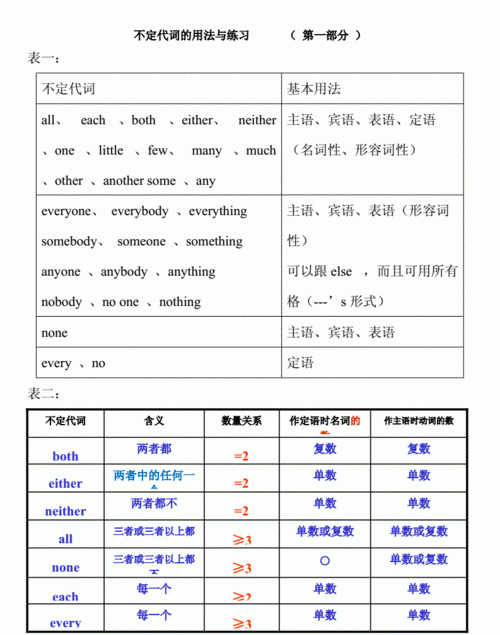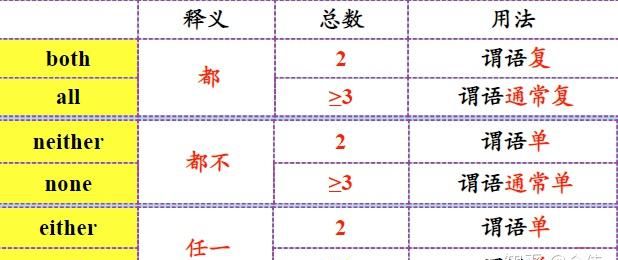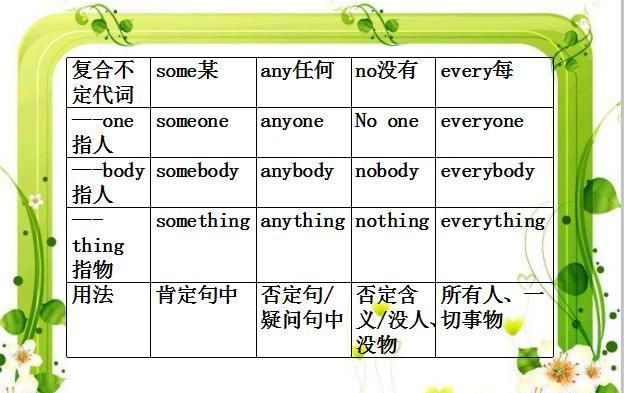本文目录
some,any,no,every构成的复合不定代词的用法
由some, any ,no, every.构成的复合不定代词的用fa
由some,any,no,every.构成的复合不定代词的用法
由some, any ,no, every.构成的复合不定代词的用法
▲由some;any ;no 和every 可以与one ,body ,thing构成复合不定代词,它们的用法与some. any
的用法相同。如:
-some
-any
-no
-every
-body
Somebody(有人,某人)
Anybody(任何人)
Nobody(没有人)
Everybody(每人,人人)
-one
Someone(有人,某人)
Anyone(任何人)
No one(没有人)
Everyone(人人,每人)
-thing
Something(某事)
Anything(任何事)
Nothing(没有东西)
Everything(一切,事事)学习时请特别注意以下几点:
1.以上不定代词做主语时,谓语动词用单数形式.Everyoneishere.
2.不定代词被形容词、动词不定式修饰时,该形容词、动词不定式要放在其后。
Ihavesomethingimportanttotellyou.
3.在表示请求、建议或邀请等期待一个肯定回答时,用some系列,而不用any系列。
CanIgetsomethingtodrink?
4.any系列一般用于否定句和疑问句中,但如有必要也可用于肯定句或if条件从句中,表示“任何人(物/事)”的含义.
Idon'thaveanythingtosay.Ilikeourschoollibrary,IcanreadanythingIlike.Ifanyoneknowstheanswer,handsup.
5.当句中有little,few,seldom,hardly,never,without等半否定意义的副词、形容词、介词或如too…to等具有否定意义的其它结构时,通常用any系列词项。如:Iseldomeatanythinginthemorning,becauseofnotime.
6.every系列一般用于肯定句中,如果用于否定句则表示部分否定(不完全否定)。如:
Noteveryonelikessmoking.=Everyonedoesn'tlikesmoking.(并不是所有人喜欢抽烟.)
7.在everyone,everybody,nobody,noone(指人的不定代词)出现的上下文中,要用复数人称代词与之对应。everything,something等代替物的不定代词出现的上下文中,要用单数it来代替。
Everyoneishere,aren'tthey?Yes,theyareintheclassroom.
EverythingisOK,soitis!
8.当陈述句的主语是指人的复合不定代词(-one,-body)时,其反意疑问部分的主语用they,
当陈述句的主语是指物的复合不定代词(-thing)时,其反意疑问部分的主语用it.(同第七条例子)
9.回答howmany或howmuch开头的问句用none,回答who开头的问句用nobody或noone;回答what引导的问句用nothing。如:Howmanybooksdoyouhave/howmuchmoneydoyouhave?None
Whoisintheclassroom?Nobody/Noone.
Whatcanyouseeontheblackboard?Nothing.
10.注意none,nothing,noone的区别:none可以和of连用,其它的不能和of连用;
Noneofusis/areright.
none与all反义。
作主语时,谓语动词可用单数,也可用复数。None(指人或物)=nothing(物)+noone/nobody(人

英语中的不定代词是什么意思
你的问题太大了吧!
建议你去教育网
或找语法书
不定代词是指不确定的数目,它的用法和名词的单复数,可数和不可数有关,有的用于不同的句子中如:肯定句、否定句和疑问句等,是否可以和of连用等方面。参考下面的表格
用于可数名词
用于不可数名词
单数
复数
none (of)指人或物
nobody指人, no one指人
nothing指物
回答how many/much问句时,用none
none (of)指人或物
none (of)指人或物
no指人或物 (=not a)
He is no fool. (他决不是蠢人)
no指人或物
(=not any +名词复数)
no other +名词复数
no指物
(=not any +不可数名词)
one (of)指人或物
one another
ones指人或物
that指物
The weather here is better than that in Shanghai.
half(of)指人或物
half (of)指人或物
half (of)指物
the other指人或物
the other +名词单数
指人或物 (和One连用)
(the) others指人或物
(the) other+名词复数,指人或物
(和some 连用)
(the) other +不可数名词,指物
(和some 连用)
another指人或物
another +名词单数
指人或物
any others指人或物
some others指人或物
--
either (of) 指人或物
neither (of) 指人或物
--
--
--
both (of) 指人或物
可作同谓语 We are both students.
--
each (of), each one, each other
指两个或两个以上的人或物。侧重个体。
可作同谓语 We gave them a present each.
--
--
every 每一个(作定语)
every other day
everybody(one) 人
every one(of) 人或物
指三个或三个以上的人和物。侧重全体。
every two days
--
--
few (具有否定意义)
a few
quiet few
a good few
little(具有否定意义)
a little
a bit of
--
fewer (of)
fewest (of)
less (of)
less (of)
--
several (of) 几个
some
someone
something
用于肯定句,和表示请求的句子
some (of)
some more (+名词复数)
some(of)
some more(不可数名词)
--
many (of)
more(of)
most (of)
much (of)
more (of)
most (of)
--
lots of许多
a lot (of)许多
plenty of很多
a great/good many
numbers of
a great/good/large number of大量的
lots of许多
a lot (of)许多
plenty of很多
a great/good deal/amount of大量的
a quantity of
quantities of
any (of) 指人或物
anyone, anything
用于否定,疑问和条件句中。
any (of) 指人或物
any things
any more
any (of) 指物
any more
all (of) 指人和物
All is not gold that glisters.
all (of) 指人和物
可作同谓语 I know them all.
We all know them well.
all (of)
I spent all of my money on books
--
enough (of) 指人或物
enough (of) 指物
such指人或物
such指人或物
such指物
the last+名词单数,指人或物
the last+名词复数,指人或物
the next+名词单数,指人或物
the next+名词复数,指人或物

我想要英语句型
英语语法体系表
语法网络图
一.名词
I. 名词的种类:
专有名词
普通名词
国名地名人名,团体机构名称
可数名词
不可数名词
个体名词
集体名词
抽象名词
物质名词
II. 名词的数:
1. 规则名词的复数形式:
名词的复数形式,一般在单数形式后面加-s或-es。现将构成方法与读音规则列表如下:
规则
例词
1
一般情况在词尾加-s
map-maps, sea-seas, girl-girls, day-days
2
以s, x, ch, sh结尾的名词后加-es
class-classes, box-boxes, watch-watches, dish-dishes
3
以-f或-fe结尾的词
变-f和-fe为v再加-es
leaf-leaves, thief-thieves, knife-knives, loaf-loaves, wife-wives
加-s
belief-beliefs, chief-chiefs, proof-proofs, roof-roofs, gulf-gulfs
4
以辅音字母加y结尾的名词,变y为i加-es
party-parties, family-families, story-stories, city-cities
5
以元音字母加y结尾的名词,或专有名词以y结尾的,加-s
toy-toys, boy-boys, day-days, ray-rays, Henry-Henrys
6
以辅音字母加-o结尾的名词
一般加-es
hero-heroes, Negro-Negroes, potato-potatoes, tomato-tomatoes
不少外来词加-s
piano-pianos, photo-photos, auto-autos, kilo-kilos, solo-solos
两者皆可
zero-zeros/zeroes, volcano-volcanoes/ volcanos
7
以元音字母加-o结尾的名词加-s
radio-radios, bamboo-bamboos, zoo-zoos
8
以-th结尾的名词加-s
truth-truths, mouth-mouths, month-months, path-paths,
2. 不规则名词复数:
英语里有些名词的复数形式是不规则的,现归纳如下:
规则
例词
1
改变名词中的元音字母或其他形式
man-men, woman-women, foot-feet, goose-geese, mouse-mice
2
单复数相同
sheep, deer, series, means, works, fish, species li, yuan, jin,
3
只有复数形式
ashes, trousers, clothes, thanks, goods, glasses, compasses, contents
4
一些集体名词总是用作复数
people, police, cattle, staff
5
部分集体名词既可以作单数(整体)也可以作复数(成员)
audience, class, family, crowd, couple, group, committee, government, population, crew, team, public, enemy, party
6
复数形式表示特别含义
customs(海关), forces(军队), times(时代), spirits(情绪), drinks(饮料), sands(沙滩), papers(文件报纸), manners(礼貌), looks(外表), brains(头脑智力), greens(青菜), ruins(废墟)
7
表示“某国人”
加-s
Americans, Australians, Germans, Greeks, Swedes, Europeans
单复数同形
Swiss, Portuguese, Chinese, Japanese
以-man或-woman结尾的改为-men,-women
Englishmen, Frenchwomen
8
合成名词
将主体名词变为复数
sons-in-law, lookers-on, passers-by, story-tellers, boy friends
无主体名词时将最后一部分变为复数
grown-ups, housewives, stopwatches
将两部分变为复数
women singers, men servants
III. 名词的所有格:
名词在句中表示所有关系的语法形式叫做名词所有格。所有格分两种:一是名词词尾加’s构成,二是由介词of加名词构成。前者多表示有生命的东西,后者多表示无生命的东西。
1. ’s所有格的构成:
单数名词在末尾加’s
the boy’s father, Jack’s book, her son-in-law’s photo,
复数名词
一般在末尾加’
the teachers’ room, the twins’ mother,
不规则复数名词后加’s
the children’s toys, women’s rights,
以s结尾的人名所有格加’s或者’
Dickens’ novels, Charles’s job, the Smiths’ house
表示各自的所有关系时,各名词末尾均须加’s
Japan’s and America’s problems, Jane’s and Mary’s bikes
表示共有的所有关系时在最后一词末加’s
Japan and America’s problems, Jane and Mary’s father
表示"某人家""店铺",所有格后名词省略
the doctor’s, the barber’s, the tailor’s, my uncle’s
2. ’s所有格的用法:
1
表示时间
today’s newspaper, five weeks’ holiday
2
表示自然现象
the earth’s atmosphere, the tree’s branches
3
表示国家城市等地方的名词
the country’s plan, the world’s population, China’s industry
4
表示工作群体
the ship’s crew, majority’s view, the team’s victory
5
表示度量衡及价值
a mile’s journey, five dollars’ worth of apples
6
与人类活动有特殊关系的名词
the life’s time, the play’s plot
7
某些固定词组
a bird’s eye view, a stone’s throw, at one’s wit’s end(不知所措)
3. of所有格的用法:
用于无生命的东西:the legs of the chair, the cover of the book
用于有生命的东西,尤其是有较长定语时:the classrooms of the first-year students
用于名词化的词:the struggle of the oppressed
?
二.冠词
冠词分为不定冠词(a, an),定冠词(the),和零冠词。
I. 不定冠词的用法:
1
指一类人或事,相当于a kind of
A plane is a machine that can fly.
2
第一次提及某人某物,非特指
A boy is waiting for you.
3
表示“每一”相当于every,one
We study eight hours a day.
4
表示“相同”相当于the same
We are nearly of an age.
5
用于人名前,表示不认识此人或与某名人有类似性质的人或事
A Mr. Smith came to visit you when you were out
That boy is rather a Lei Feng.
6
用于固定词组中
A couple of, a bit, once upon a time, in a hurry, have a walk, many a time
7
用于quite, rather, many, half, what, such之后
This room is rather a big one.
8
用于so(as, too, how)+形容词之后
She is as clever a girl as you can wish to meet.
II. 定冠词的用法:
1
表示某一类人或物
The horse is a useful animal.
2
用于世上独一无二的事物名词前
the universe, the moon, the Pacific Ocean
3
表示说话双方都了解的或上文提到过的人或事
Would you mind opening the door?
4
用于乐器前面
play the violin, play the guitar
5
用于形容词和分词前表示一类人
the reach, the living, the wounded
6
表示“一家人”或“夫妇”
the Greens, the Wangs
7
用于序数词和形容词副词比较级最高级前
He is the taller of the two children.
8
用于国家党派等以及江河湖海,山川群岛的名词前
the United States, the Communist Party of China, the French
9
用于表示发明物的单数名词前
The compass was invented in China.
10
在逢十的复数数词之前,指世纪的某个年代
in the 1990’s
11
用于表示单位的名词前
I hired the car by the hour.
12
用于方位名词,身体部位名词,及表示时间的词组前
He patted me on the shoulder.
III. 零冠词的用法:
1
专有名词,物质名词,抽象名词,人名地名等名词前
Beijing University, Jack, China, love, air
2
名词前有this, my, whose, some, no, each, every等限制
I want this book, not that one. / Whose purse is this?
3
季节,月份,星期,节假日,一日三餐前
March, Sunday, National Day, spring
4
表示职位,身份,头衔的名词前
Lincoln was made President of America.
5
学科,语言,球类,棋类名词前
He likes playing football/chess.
6
与by连用表示交通工具的名词前
by train, by air, by land
7
以and连接的两个相对的名词并用时
husband and wife, knife and fork, day and night
8
表示泛指的复数名词前
Horses are useful animals.
三.代词:
I. 代词可以分为以下七大类:
1
人称代词
主格
I, you, he, she, it, we, you, they
宾格
me, you, him, her, it, us, you, them
2
物主代词
形容词性
my, your, his, her, its, our, their
名词性
mine, yours, his, hers, its, ours, theirs
3
反身代词
myself, yourself, himself, herself, itself, ourselves, yourselves, themselves
4
指示代词
this, that, these, those, such, some
5
疑问代词
who, whom, whose, which, what, whoever, whichever, whatever
6
关系代词
that, which, who, whom, whose, as
7
不定代词
one/ some/ any, each/ every, none/ no, many/ much, few/ little/ a few/ a little,
other/ another, all/ both, neither/ either
II. 不定代词用法注意点:
1. one, some与any:
1) one可以泛指任何人,也可特指,复数为ones。some多用于肯定句,any多用于疑问句和否定句。
One should learn to think of others.
Have you any bookmarks? No, I don’t have any bookmarks.
I have some questions to ask.
2) some可用于疑问句中,表示盼望得到肯定的答复,或者表示建议,请求等。
Would you like some bananas? Could you give me some money?
3) some 和any修饰可数名词单数时,some表示某个,any表示任何一个。
I have read this article in some magazine. Please correct the mistakes, if any.
4) some和数词连用表示“大约”,any可与比较级连用表示程度。
There are some 3,000 students in this school. Do you feel any better today?
2. each和every:
each强调个别,代表的数可以是两个或两个以上,而every强调整体,所指的数必须是三个或三个以上。
Each student has a pocket dictionary. / Each (of us) has a dictionary. / We each have a dictionary.
Every student has strong and weak points. / Every one of us has strong and weak points.
3. none和no:
no等于not any,作定语。none作主语或宾语,代替不可数名词,谓语用单数,代替可数名词,谓语单复数皆可以。
There is no water in the bottle.
How much water is there in the bottle? None.
None of the students are (is) afraid of difficulties.
4. other和another:
1) other泛指“另外的,别的”常与其他词连用,如:the other day, every other week, some other reason, no other way,
the other特指两者中的另外一个,复数为the others。如:
He held a book in one hand and his notes in the other.
Two students in our class failed, but all the others passed the exam.
2) another指“又一个,另一个”无所指,复数形式是others,泛指“别的人或事”如:
I don’t like this shirt, please show me another (one).
The trousers are too long, please give me another pair / some others.
Some like football, while others like basketball.
5. all和both, neither和either
all表示不可数名词时,其谓语动词用单数。both和all加否定词表示部分否定,全部否定用neither和none.
All of the books are not written in English. / Not all of the books are written in English.
Both of us are not teachers. / Not both of us are teachers. / Either of us is a teacher.
四.形容词和副词
I. 形容词:
1. 形容词的位置:
1) 形容词作定语通常前置,但在下列情况后置:
1
修饰some, any, every, no和body, thing, one等构成的复合不定代词时
nobody absent, everything possible
2
以-able, -ible结尾的形容词可置于有最高级或only修饰的名词之后
the best book available, the only solution possible
3
alive, alike, awake, aware, asleep等可以后置
the only person awake
4
和空间、时间、单位连用时
a bridge 50 meters long
5
成对的形容词可以后置
a huge room simple and beautiful
6
形容词短语一般后置
a man difficult to get on with
2) 多个形容词修饰同一个名词的顺序:
代词
数词
性状形容词
冠词前的形容词
冠词
指示代词
不定代词
代词所有格
序数词
基数词
性质
状态
大小
长短
形状
新旧
温度
颜色
国籍
产地
材料
质地
名词
all
both
such
the
a
this
another
your
second
next
one
four
beautiful
good
poor
large
short
square
new
cool
black
yellow
Chinese
London
silk
stone
3) 复合形容词的构成:
1
形容词+名词+ed
kind-hearted
6
名词+形容词
world-famous
2
形容词+形容词
dark-blue
7
名词+现在分词
peace-loving
3
形容词+现在分词
ordinary-looking
8
名词+过去分词
snow-covered
4
副词+现在分词
hard-working
9
数词+名词+ed
three-egged
5
副词+过去分词
newly-built
10
数词+名词
twenty-year
II. 副词
副词的分类:
1
时间副词
soon, now, early, finally, once, recently
5
频度副词
always, often, frequently, seldom, never
2
地点副词
here, nearby, outside, upwards, above
6
疑问副词
how, where, when, why
3
方式副词
hard, well, fast, slowly, excitedly, really
7
连接副词
how, when, where, why, whether, however, meanwhile
4
程度副词
almost, nearly, very, fairly, quite, rather
8
关系副词
when, where, why
III. 形容词和副词比较等级:
形容词和副词的比较等级分为原级,比较级和最高级。比较级和最高级的构成一般是在形容词和副词后加-er和-est,多音节和一些双音节词前加more 和most。
1. 同级比较时常常用 as…as…以及not so(as)…as…如:I am not so good a player as you are.
2. 可以修饰比较级的词有:much, many, a lot, even, far, a bit, a little, still, yet, by far, any, a great deal。
3. 表示一方随另一方变化时用“the more…the more…”句型。如:The harder you work, the more progress you will make.
4. 用比较级来表达最高级的意思。如:I have never spent a more worrying day.
5. 表示倍数的比较级有如下几种句型:
Our school is three times larger than yours./Our school is four times as large as yours./Our school is four times the size of yours.
6. 表示“最高程度“的形容词没有最高级和比较级。如:favourite, excellent, extreme, perfect。


以上就是关于不定代词表格图 ,some,any,no,every构成的复合不定代词的用法的全部内容,以及不定代词表格图 的相关内容,希望能够帮到您。

